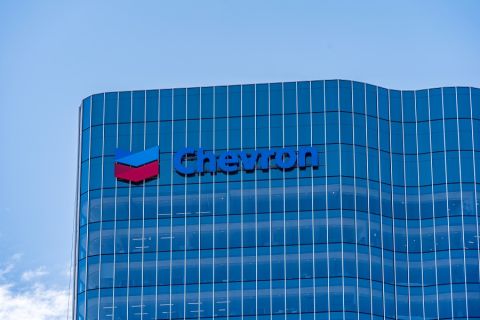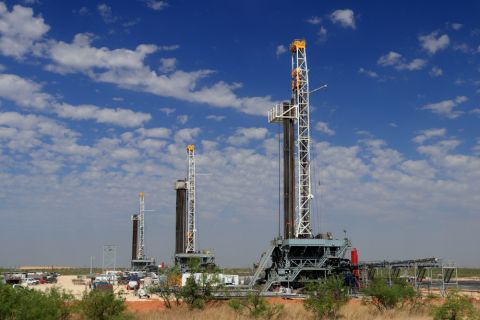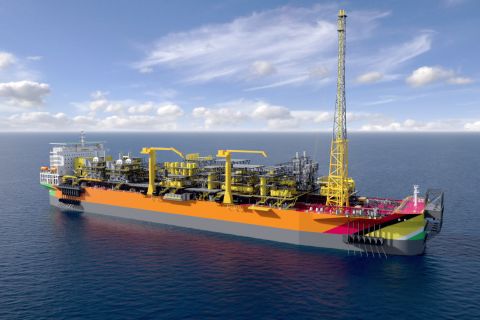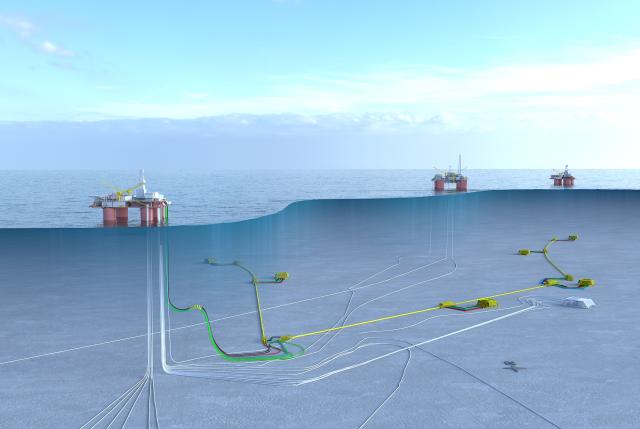
FIGURE 1. Offshore operations continue on Equinor’s SEP. (Source: Equinor)
[Editor's note: This story originally appeared in the April 2020 edition of E&P. Subscribe to the magazine here.]
The Snorre Field located in the Tampen area of the Norwegian Continental Shelf is a giant reserve that has so far produced 1.4 Bbbl of oil and gas since August 1992. To add additional volumes from the Snorre Field, the Snorre partners decided to sanction the Snorre Expansion Project (SEP).
As a part of the project, Equinor signed a contract with Subsea 7 in June 2016 that encompasses three pipeline bundles (East, West and North) and 31 spools, linking six new drilling templates with the Snorre A tension- leg platform.
Following a comprehensive marine study, Subsea 7 was awarded the contract to provide engineering, procurement, construction and installation in December 2017. The scope of work involves the provision and installation of the pipeline bundle technology with midline structures, which contain all gas and water injection flowlines, chemical and hydraulic service lines, and control umbilicals necessary for full field operation (see Figure 1 above). More than $2.36 billion is expected to be spent on raising the recovery rate from 46% to 51% with operations due to begin in 2021.
Milestones
For more than 40 years, Subsea 7 has installed 82 pipeline bundle systems that essentially carry and contain any combination of pipelines and umbilicals. Individual components are terminated in towheads where manifolds are housed. Such an integrated formation delivers incremental capex savings for the client.
Largely resourced, engineered and managed from Aberdeen, U.K., fabrication and testing of the three bundles began in mid-2018 at the company’s Wester fabrication site in Wick, U.K. The West bundle was the first to be installed in water depths of between 300 m and 380 m in July 2019. The remaining two bundles (East and North) with spools and tie-ins will be transported using Subsea 7’s Controlled Depth Tow Method and connected by the middle of the year. Including significant intermediate structures, the total length of the three bundles is more than 20,000 m. At 7.6 km long, the West pipeline bundle is one of the longest ever executed and currently possible at the Wester site.
Likewise, the East bundle system has achieved notable milestones being the largest in diameter to date (58 inches) and the heaviest installed by the global contractor at 12,600 mt. It also contains four pipe-in-pipe insulated production flowlines—a first for the company. The total tie-in spool length is equal to 3.4 km of pipe spools, 7.6 km of tubing spools and 3.7 km of flying leads. Through the Subsea Integration Alliance, Subsea 7 and OneSubsea also supplied the complete subsea control system and topside elements, including the electrical power units and the subsea gateway to control the bundle system.
The SEP includes massive midline towheads to tie into the midline drill centers across each of the three bundle systems. For example, to land the leading towhead of the West bundle beside a drill center, about 2 km of bundle carrier pipe had to be deflected through a 2,000-m radius. For safe and efficient tow and installation, each towhead had two buoyancy tanks attached, which were removed on reaching its destination.
Space, safety and sustainability savings
As an already heavily congested field, the use of Subsea 7’s pipeline bundle reduced the installation footprint, thereby saving space and providing improved access for drill rigs compared to traditional pipelay methods. With reduced installation time offshore, this equates to reduced operational risk.
As the field has been in existence for more than 20 years, there is a number of crossings for the bundles to safely bridge and a largely soft clay terrain to install each of the three bundle systems. This led to the application of a framework for tolerably mobile foundations in the Norwegian trench. As the field is already equipped with permanent reservoir monitoring cables, trenching was not possible. Likewise, as the carrier pipe has a large diameter and is designed for impact, there was no need to place about 450,000 mt of protective rock. This saves considerable procurement and material costs as well as further disruption to the crowded seabed.
The Department of Environment, Food and Rural Affairs Select Committee in the U.K. and the Norwegian Oil & Gas Association were both consulted to analyze the potential environmental impact of the project and advise where energy consumption and emissions could be reduced.
The drive to invest and implement new technology was also key for the project to reduce costs and environmental impact. For instance, electrification allowed for smaller towhead sizes and reduced trawl loads, and therefore significantly less hydraulic fluid was needed subsea.
Eighteen subsea electronic actuators also will be permanently deployed. These are capable of 2,700 newton meters of torque controlled by the six communication distribution units housed in five different towheads. Another world first is the use of an all-polymer subsea connector within the pipeline bundles. Developed by Subsea 7, the Swagelining integrated polymer lining system now features LinerBridge connector technology, which increases the cost-effectiveness of polymer lined pipeline systems. This represents a step change in options for tackling costly internal corrosion of pipelines and risers while creating a robust and fully integrated polymer barrier within the pipeline system (Figure 2).
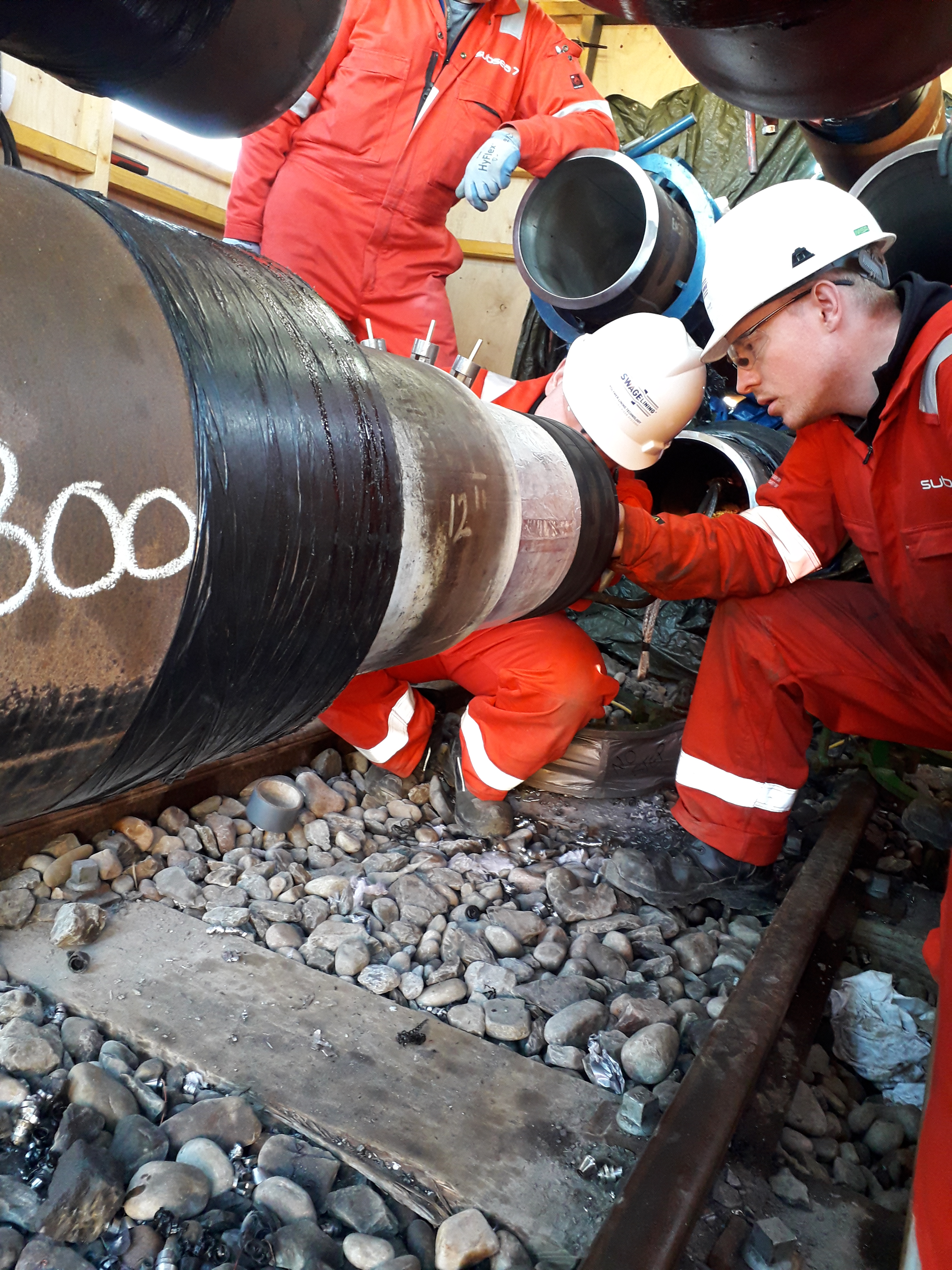
Future-proofing and potential
From the outset of the FEED stage, the bundles were designed to provide a platform for digitalization in future years. The towheads also were designed to allow data transfer via fiber-optic cables to autonomous inspection vehicles (AIVs). This has essentially created the long-term vision for the towheads to become singular docking stations for underwater intervention drones with the Snorre towheads. Additionally, fiber optics can provide the ability to measure the temperature in the bundle annulus, along with providing acoustic leak detection and functionality.
With the aim of significantly reducing opex, as well as minimizing environmental impact, industry leaders are embracing the future value of pipeline bundles as hosts for autonomous subsea vehicles. These drones can potentially be the resident eyes and ears on the seabed, reducing the need for a field support vessel to oversee all inspection, repair and maintenance activities.
i-Tech 7, Subsea 7’s life-of-field business unit, has been actively developing its AIV capability to support and maintain the integrity of subsea production assets for more than two decades.
Installation of the West bundle has successfully taken place, and the towhead load-out and installation of the North and East bundles, spools and tie-ins are expected to be completed in late 2020.
Recommended Reading
Chevron Hunts Upside for Oil Recovery, D&C Savings with Permian Pilots
2024-02-06 - New techniques and technologies being piloted by Chevron in the Permian Basin are improving drilling and completed cycle times. Executives at the California-based major hope to eventually improve overall resource recovery from its shale portfolio.
Exxon Ups Mammoth Offshore Guyana Production by Another 100,000 bbl/d
2024-04-15 - Exxon Mobil, which took a final investment decision on its Whiptail development on April 12, now estimates its six offshore Guyana projects will average gross production of 1.3 MMbbl/d by 2027.
TPH: Lower 48 to Shed Rigs Through 3Q Before Gas Plays Rebound
2024-03-13 - TPH&Co. analysis shows the Permian Basin will lose rigs near term, but as activity in gassy plays ticks up later this year, the Permian may be headed towards muted activity into 2025.
CEO: Continental Adds Midland Basin Acreage, Explores Woodford, Barnett
2024-04-11 - Continental Resources is adding leases in Midland and Ector counties, Texas, as the private E&P hunts for drilling locations to explore. Continental is also testing deeper Barnett and Woodford intervals across its Permian footprint, CEO Doug Lawler said in an exclusive interview.
Pitts: Heavyweight Battle Brewing Between US Supermajors in South America
2024-04-09 - Exxon Mobil took the first swing in defense of its right of first refusal for Hess' interest in Guyana's Stabroek Block, but Chevron isn't backing down.

